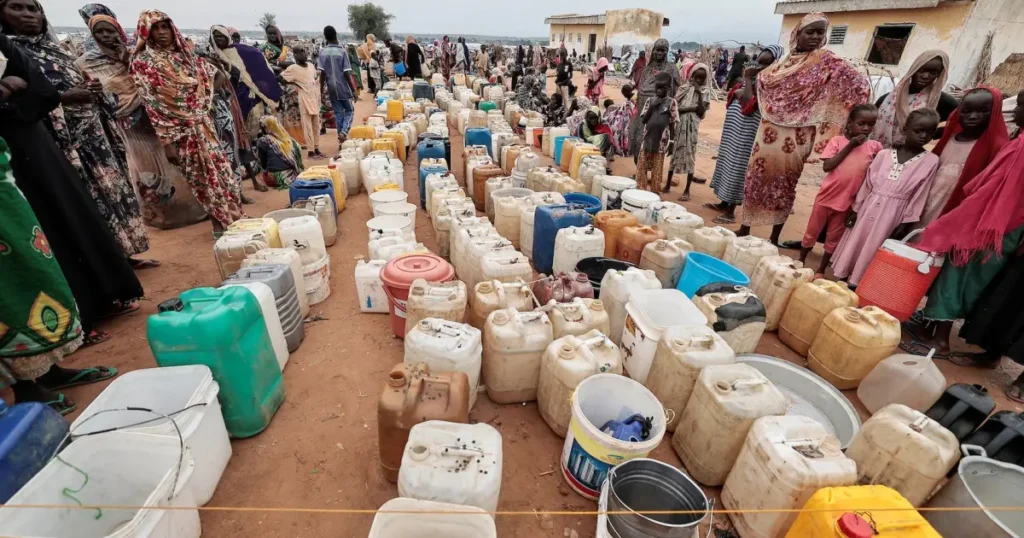Food & Climate
There is a horrific famine conditions in parts of North Darfur and an increasing risk of famine in other settlements and conflict-affected areas, and La Niña will worsen Sudan hunger, The Food and Agriculture Organization of the United Nations (FAO), said today.
In April 2023, fighting between the leaders of the Sudanese Armed Forces (SAF) and a powerful paramilitary group known as the Rapid Support Forces (RSF) has broken out.
In response to alarming new findings confirming famine conditions in parts of North Darfur , (FAO) is urging an immediate cessation of hostilities, rapid scale up of life-saving food, nutrition and cash assistance as well as of the emergency agricultural aid.
This is critical in conflict-affected areas to address immediate needs and avert the risk of famine from increasing and affecting other locations across the country.
The IPC Famine Review Committee (FRC) has conclusively found that Famine conditions are ongoing in the Zamzam Internally Displaced Persons (IDP) camp which hosts 500,000 IDPs outside of El Fasher town in Darfur, according FAO press release which “Food & Climate” platform received today.
Sudan is engulfed in an unparalleled food security crisis, facing the worst levels of hunger ever recorded by the IPC in the country, as well as the world’s largest internally displaced crisis. A staggering 755 000 people are currently facing catastrophic levels of acute hunger (IPC Phase 5) – the worst form of hunger – while a total of 25.6 million people are experiencing high levels of acute hunger (IPC Phases 3 and above).
Horrific famine
“We are witnessing horrific famine conditions in parts of North Darfur and an increasing risk of famine in other settlements and conflict-affected areas, especially in Darfur, South Kordofan, Khartoum and Al Jazirah,” said FAO Director-General QU Dongyu.
“We have been raising the alarm about this looming catastrophe, yet due to the ongoing conflict and limited humanitarian access these communities are still not getting the immediate support they need. We need urgent, concerted action to prevent an even greater catastrophe from unfolding. Famine can be halted, but the immediate cessation of hostilities is an essential first step”, he added.
Sudan is highly dependent on agriculture with nearly 65 percent of population engaged in the sector. And it is this sector, rural livelihoods and agrifood systems that are on the front line of the conflict, suffering severe damage and disruption – with cascading and worrying consequences for food security and nutrition.

The situation is likely to be further exacerbated by above-average rainfall and higher-than-average temperatures predicted across southern and central states in the Sudan due to the projected La Niña conditions from August–September. The potential flooding may increase the risk of additional crop and livestock losses, while limited humanitarian access is worsening food supply and increasing the risk of severe starvation, FAO warns.
Distributing seeds
FAO is distributing seeds to 1.2 million farming households for the main planting season, which began in June. The campaign focuses on distributing seeds to around 6 million people across the country, including Al Jazirah, Blue Nile, White Nile, the Greater Darfur and Kordofan regions where food insecurity levels are highest. If FAO’s seeds campaign is fully implemented, it will allow farmers to produce a projected harvest of 2.4 to 3.6 million tonnes of sorghum grain.
Critical livestock, fisheries and social protection interventions also remain heavily underfunded. FAO is providing vital veterinary services and plans to provide emergency livestock and fishery supplies, which is crucial for preserving the primary source of nutrition and income for millions, mitigating soaring malnutrition rates among children and stabilizing livelihoods amidst the escalating crisis.
So far in 2024, FAO and its partners have vaccinated more than 2.7 million animals against common livestock diseases, reaching over half a million pastoral and agropastoral households. A further 2.5 million animals are targeted to receive veterinary support during the winter season (November to February) benefiting a total of 170 000 households.

